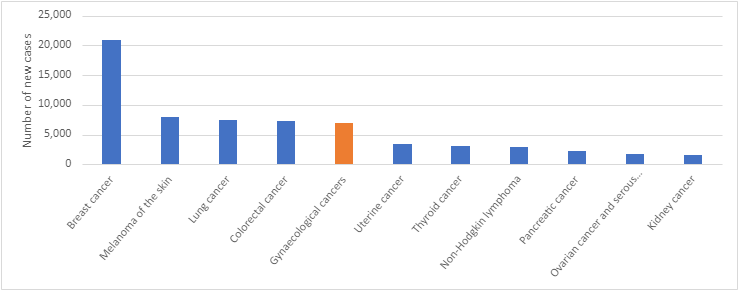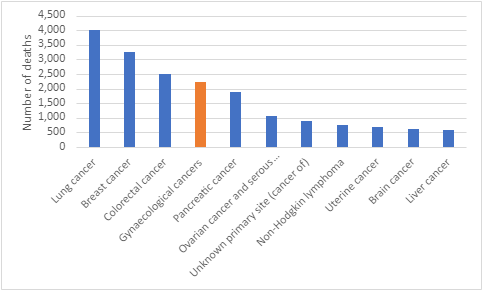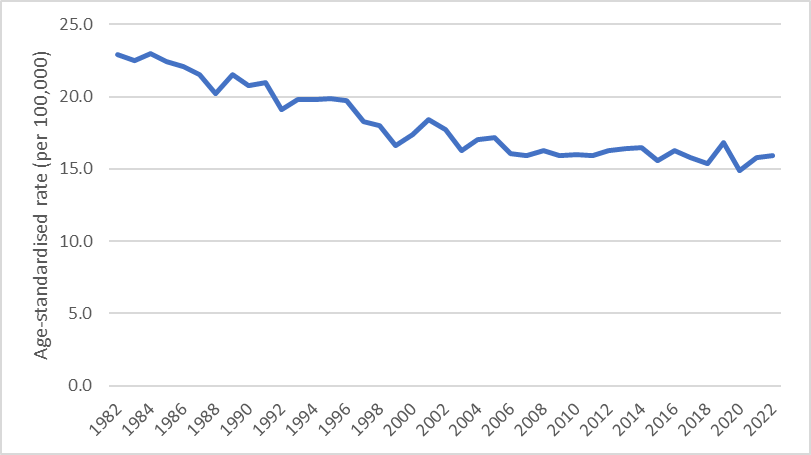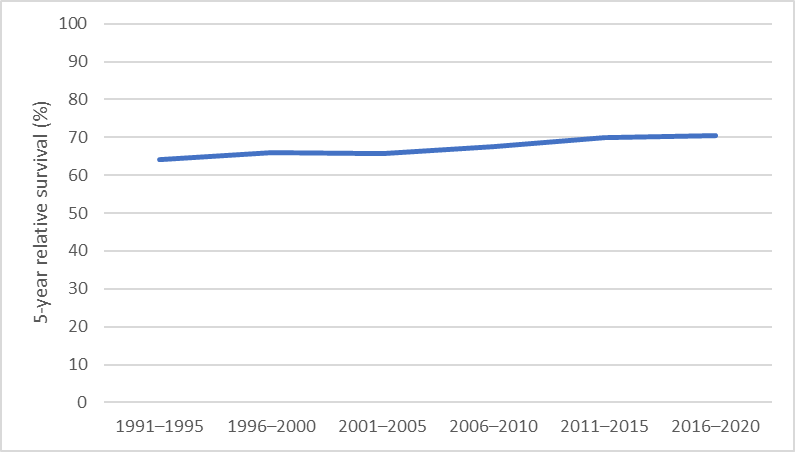Cancer Australia is currently updating the statistics on this page in alignment with the new Cancer Data in Australia report published by the Australian Institute of Health and Welfare on 8 October 2025.
The following material has been sourced from the Australian Institute of Health and Welfare
Gynaecological cancers incorporates ICD-10 cancer codes C51 (Malignant neoplasm of vulva), C52 (Malignant neoplasm of vagina), C53 (Malignant neoplasm of cervix), C54 (Malignant neoplasm of corpus uteri), C55 (Malignant neoplasm of uterus, part unspecified), C56 (Malignant neoplasm of ovary), C57 (Malignant neoplasm of other and unspecified female genital organs) and C58 (Malignant neoplasm of placenta).
New cases
In 2020, there were 6,380 new cases of gynaecological cancers diagnosed in Australia. In 2024, it is estimated that 6,963 new cases of gynaecological cancers will be diagnosed in Australia. In 2024, it is estimated that a female has a 1 in 23 (or 4.3%) risk of being diagnosed with a gynaecological cancer by the age of 85.

Notes
- Data sourced from AIHW Cancer Data in Australia 2024 web report and supplementary data tables
- More information about incidence rates for the most common cancers diagnosed can be found on the NCCI website in the ‘Cancer incidence’ section (https://ncci.canceraustralia.gov.au/diagnosis/cancer-incidence/cancer-incidence)
In 2020, the age-standardised incidence rate was 49 cases per 100,000 females. In 2024, it is estimated that the age-standardised incidence rate will be 49 cases per 100,000 females. The incidence rate for gynaecological cancers is expected to increase with age, highest for those aged 75–79 years.

Notes
- Data sourced from AIHW Cancer Data in Australia 2024 web report and supplementary data tables
- Age standardised rates are standardised to the 2024 Australian Standard Population.
- More information about incidence rates for gynaecological cancers over time, by age, Indigenous status, remoteness, and socioeconomic status (SES) can be found on the NCCI website in the ‘Cancer incidence’ section (https://ncci.canceraustralia.gov.au/diagnosis/cancer-incidence/cancer-incidence)
The number of new cases of gynaecological cancers diagnosed increased from 2,954 in 1982 to 6,380 in 2020. Over the same period, the age-standardised incidence rate decreased from 51 cases per 100,000 females in 1982 to 49 cases per 100,000 females in 2020.
Deaths
In 2022, there were 2,171 deaths from gynaecological cancers in Australia. In 2024, it is estimated that there will be 2,235 deaths. In 2024, it is estimated that a female has a 1 in 73 (or 1.4%) risk of dying from a gynaecological cancer by the age of 85.

Notes
- Data sourced from AIHW Cancer Data in Australia 2024 web report and supplementary data tables
- Two sources are used for cancer mortality reporting rankings (National Mortality Database and Australian Cancer Database). Mortality data reported for cancer of unknown primary site, liver cancer and stomach cancer in the chart above is from the Australian Cancer Database. Data from the National Mortality Database is presented in-text unless it is unavailable. More information can be found at AIHW interim guidelines (https://www.aihw.gov.au/reports/cancer/cancer-data-in-australia/contents/cancer-data-commentaries/interim-guidelines-choosing-which-mortality-data)
- More information about mortality rates for the most common causes of cancer death can be found on the NCCI website in the ‘Cancer mortality’ section (https://ncci.canceraustralia.gov.au/outcomes/cancer-mortality/cancer-mortality)
In 2022, the age-standardised mortality rate was 16 deaths per 100,000 females. In 2024, it is estimated that the age-standardised mortality rate will be 16 deaths per 100,000 females. The mortality rate for gynaecological cancers is expected to increase with age.

Notes
- Data sourced from AIHW Cancer Data in Australia 2024 web report and supplementary data tables
- Age standardised rates are standardised to the 2024 Australian Standard Population.
- More information about mortality rates for gynaecological cancers over time, by age, Indigenous status, remoteness, and socioeconomic status (SES) can be found on the NCCI website in the ‘Cancer mortality’ section (https://ncci.canceraustralia.gov.au/outcomes/cancer-mortality/cancer-mortality)
The number of deaths from gynaecological cancers increased from 1,235 in 1982 to 2,171 in 2022. Over the same period, the age-standardised mortality rate decreased from 23 deaths per 100,000 females in 1982 to 16 deaths per 100,000 females in 2022.
Survival
In 2016–2020, individuals diagnosed with gynaecological cancers had a 71% chance of surviving for five years compared to their counterparts in the general Australian population. Between 1991–1995 and 2016–2020, five-year relative survival for gynaecological cancers improved from 64% to 71%.

Notes
- Data sourced from AIHW Cancer Data in Australia 2024 web report and supplementary data tables
- More information about 5-year relative survival rates for gynaecological cancers over time, by age, Indigenous status, remoteness, and socioeconomic status (SES) can be found on the NCCI website in the ‘Relative survival rate’ section (https://ncci.canceraustralia.gov.au/outcomes/relative-survival-rate/5-year-relative-survival-diagnosis)
Prevalence
At the end of 2020, there were 5,813 people living who had been diagnosed with gynaecological cancers that year, 23,332 people living who had been diagnosed with gynaecological cancers in the previous 5 years (from 2016 to 2020) and 75,924 people living who had been diagnosed with gynaecological cancers in the previous 39 years (from 1982 to 2020).
For more information, see Gynaecological cancers on the NCCI website
The National Cancer Control Indicators (NCCI) are a set of indicators across the continuum of cancer care, from Prevention and Screening through to Diagnosis, Treatment, Psychosocial care, Research and Outcomes. The NCCI website allows users to see visual representations of data on each indicator through interactive charts.

